I do still have photos from NYC and maybe even from NOLA that include actual people that I want to get on here. However, something interesting happened when I was in New York. I kept meeting people who read Tim’s and my LiveJournals. Upon hearing that they did, I expected the following questions:
1. How do you guys write together?
2. When’s your next book out?
3. Does Timothy J. Lambert really sleep in the buff?
4. What’s the deal with BBQ Fritos and how can I make Greg Herren send them to me?
5. Should I buy Famous Author Rob Byrnes a drink or donate money for his suite at Betty Ford?
But no. The most frequent question was, “What got you on the raw food kick for your dogs, and tell me more about it.”
Evidence that people love dogs more than reading, eating, and getting info on hot men.
After my dogs died in 2000 and then Margot and Guinness came to us, I stopped buying any commercially prepared dog food except Wysong. We fed them dry and flavored it with Wysong’s canned organs, beef, and chicken. But when I researched foods before I decided on Wysong, I kept finding people who recommended raw diet. There were parts (ha ha) of the raw diet that grossed me out, and I just didn’t think I could do it. I was satisfied with Wysong, and my dogs gave their hearty approval of it, so that was good enough for me.
Then River came along with his many health problems, and Tim researched how diet might exacerbate or eliminate some of those problems. Again, raw diet kept being touted. There were (and are) plenty of people against raw feeding for dogs, but they were usually people who hadn’t tried it. Some vets don’t approve of raw diet. They weren’t educated to use it, and frequently, their nutrition teachers in vet schools came from companies like Science Diet, the food you most often see sold in vet clinics. I’m not anti-Science Diet, and I’m pro-Wysong. But I wanted to get away from all commercial food, because, for example, it bothered me that Guinness scratches so much. She seems to have a problem with yeast that leads to chronic ear infections. Could it be something in her dry food causing the problem?
Those who tried raw diet talked about better breath, better coats, less skin problems, better stools, less allergies, cleaner teeth (healthy teeth are an indicator for a longer lifespan in dogs as well as people, which is why vets now offer to clean your dog’s teeth), less joint problems, less health issues that led to vet visits. Having spent thousands of dollars on three sick dogs, fewer costly vet visits sounded good. My dogs get two checkups a year, and they always will. But if anything could spare us the heartbreak of putting another three dogs to sleep, before the full life expectancy of their breeds and after a range of mystery illnesses, it was worth trying.
It’s a sad fact of life that most of us with a normal lifespan will outlive many dogs and cats who bless our lives with their love and companionship. But if something offers the hope of keeping them with us longer–and in good health during that longer life–it just makes sense. Still, though Tim and I talked about it, we knew it was going to take work, research, time, energy, and commitment, and other things seemed more pressing.
Then the pet food recall and all those animal deaths hit the news. Although none of the foods we used were involved, it seemed the story kept developing, with more disturbing details and more products added. It was the right time to jump. We’re lucky enough to have a raw food supplier in Houston, so I went there first, to get food and advice. (All that information is also available on the Internet.) Now we’re doing it all ourselves. If we ever have to board our dogs, I can see going back to her because she sells raw diet in forms that would make it easier for a vet or a kennel to feed them.
Raw diet is time consuming, I don’t deny that. My time per week probably averages five hours, mostly because I sometimes have a difficult time finding the right food at our grocery stores and making sure it’s from the USA (not China). I’m also stuck begging butchers for help, which always entails explaining things like how uncooked bones will NOT hurt the dogs. Uncooked bones are soft, and it’s fun to see the pleasure in the dogs’ eyes as they crunch on chicken and turkey necks or chunks of catfish with the bones still there. This was the biggest obstacle I had to overcome about feeding raw. I was convinced that my dogs were going to choke or get perforated intestines and die because of bones. I’m still a little iffy about rib bones, but the dogs have had no problem with the smaller bones at all. And we’ve always given large marrow bones to them as a treat. Even after they’ve cleaned them, they like to gnaw on those bones, which is great for their teeth.
Other benefits of raw food, just like I was promised: better breath, whiter teeth, stronger jaws, better weight management, less scratching, shiny coats, better sleep habits, smaller, healthier stools (I regret to say that The Compound Canines have been known, on occasion, to be poop eaters, but with raw diet, that has stopped!). Of course, the benefits I most hope for will only be evident over the long term. The dogs are completely off any dry food now, and getting all raw.
Behind the cut, I’m putting photos with more specific information about what’s working for us. If you can endure pictures of raw stuff, check it out. If you can’t, then all I can say is, yes, Tim does sleep in the buff, and no, I don’t have photos to prove it.
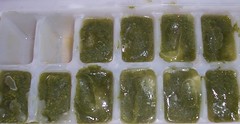
Veggie cubes. Some raw diet proponents don’t believe in feeding veggies at all, saying canines are carnivores. I don’t know that I agree, because my dogs are grazers, and they love any vegetable I’ve ever offered them. But since they can’t digest large chunks of veggies, I make a juice in the blender. There are definitely vegetables to avoid (AND NEVER FEED ONION, which in large amounts is toxic but also has a cumulative effect). You can find lists on the Internet of what’s good and bad. Usually, my blends consist of a little vegetable juice (like V8) just to help the process of juicing, along with parsley, celery, carrots, and other vegetables. I freeze them in cubes, and we add them to their meat later.
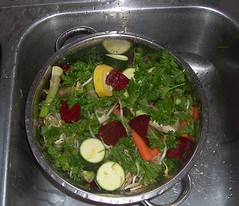
Today, I decided to try something different, so I added a raw beet. (I also took a little taste of raw beet, the first time I’ve ever tried this vegetable. It tastes like sweet dirt. I do always taste a little bit of the veggie juice after I blend it, just so I’ll know what the dogs are getting. I love vegetables, raw or cooked, but I don’t think I could drink a whole glass of their juice.) This bowl contains beets, parsley, the ends of asparagus that I snapped off of what I’m cooking for us tonight, carrots, celery, bean sprouts, zucchini, and squash. As it was being blended, it looked like this:
 Pretty and red!
Pretty and red![June 2009, ETA: I no longer use V8 because tomato can irritate dogs’ stomachs. I cut back on zucchini and squash to limit “nightshade” vegetables. I often add lettuce and green beans.]
Time to take the cleaver to the turkey necks!

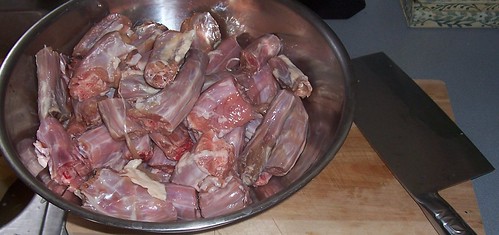
Bowl of chopped necks.
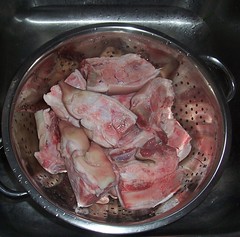
A bowl full of a real canine crowd pleaser, sliced pigs’ feet. They LOVE these bones. They also really love chicken feet. Yucky for us to watch, but delicious for them.
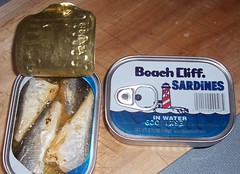
A couple of cans of sardines in water, just to crumble and add to their food for smell and because the fish oil is good for them.
When we first started feeding raw, we got fish oil capsules as a one-a-day supplement. But if you add fish to their food, they’ll get the oil that way. We also used a probiotic powder to help their systems “learn” to produce the right enzymes and flora for digesting raw. Sources say that after they’ve completely adjusted to the new raw diet, they don’t need that any more.
Another thing, not pictured here, is adding a raw egg, including the shell, to their food. We only give Margot and Guinness one a week. I’m not sure how often Rex gets raw egg. The dogs love it. We did this for our dogs when I was a kid, then we stopped because of salmonella scares. The thing is, dogs’ digestive systems are not like ours, so they are better able to handle bacteria than we are. Some people add grapefruit seed extract to help cleanse bacteria from the raw food, but Tim doesn’t think this is necessary. However, you can also use the grapefruit seed extract to clean your food prep area. I use soap and water, as well as vinegar, on my dishes, cutting board, sink, and my counters after preparing their food.
With beef liver (I also use heart, but I’m not as crazy about kidneys), the pictures get all horror movie:

[June 2009, ETA: We have stopped feeding liver, as overconsumption of liver can cause muscle weakness and trembling. We also sporadically supplement with Wysong to keep the girls’ weight up, and we give a dollop of plain yogurt with every meal.]
Now I’ve got all the ingredients to start filling their bags of food. I use a food scale.

Turkey neck, veggie cube, bit of crumbled sardine, and liver.
The girls get eight ounces twice a day (it varies by dog and by what I think they need to maintain their best weight). Rex gets ten ounces twice a day. Our dogs have never been allowed to free feed, so they are used to eating their entire meal at one time. It takes the girls forty-five seconds to a minute and a half to finish a bowl of food, depending on the amount of good crunchy bones in it.
Is it more expensive? Yes. More time consuming? Yes. But over the long term? Probably not, as you may understand if you’ve ever had a pet with a catastrophic illness and spent a lot of time shuttling him or her to and from vets, sitting in examining rooms, and handing over your Mastercard.
Not all dogs do well on a raw diet. Older dogs, immune-compromised dogs, and dogs with gastro-intestinal problems should not be changed to raw diet without consulting a vet. But do try to find a vet who’ll answer solely on the basis of your dog’s health and not in just a knee-jerk RAW IS BAD! way.
Not everyone has the time to shop and prepare a raw diet for their dogs. What we’re doing is a little scary, but we’ll be monitoring our dogs’ health every step of the way. If something’s not working or we have a problem, I won’t hesitate to say so here on my LiveJournal. I would recommend that anyone do a lot of research before they make any changes to a dog’s diet, but I will say that I’ll never, ever give my dogs cooked bones again (even the ones people say are “safe”). And even if I were feeding commercial food or home-cooked meals, I’d add in raw marrow bones for their dental health (and the benefits of the marrow itself).

Anyone for a blood shake? And hey where do I get some better stools for the kitchen?
That’s a BEET shake, and I’ll be happy to make you one! Dash can help you with that kitchen thing.
Beet shake? ewww … I think that’s worse then the bloodshake.
What are you talking about? I thought you do have a photo of me sleeping in the nude.
You know what? You’re right. I do.
Since I started feedin Rutlie more raw foods, he is doing so much better with his eating habits and his tummy ache stuff. He loves the chicken necks and liver. I still use wysong dry, but I mix a portion of it with his raw food. I also bought wysong’s dried innards for treats. I have not done the frozen veggie cubes yet, but I think I will start that next week. I have to work slowly, real slow, with Rut because of his tummy.
I bet Dakota would *love* this, since owning a vegetarian (yes, my dog owns me; I know the score) means he doesn’t get any real meat, but I don’t know if my stomach could hack it.
And everyone knows that the answer to #5 is, of course, both.
Jeffrey R.
You are correct on number five, I think!
I didn’t know you’re a vegetarian. I think that’s so admirable because I’ve never had the strength to make that change.
It’s amazing how quickly I’m getting adjusted to “hacking” meat. If Dakota ever came to The Compound Canine Cafe, he’d probably think he was in heaven.